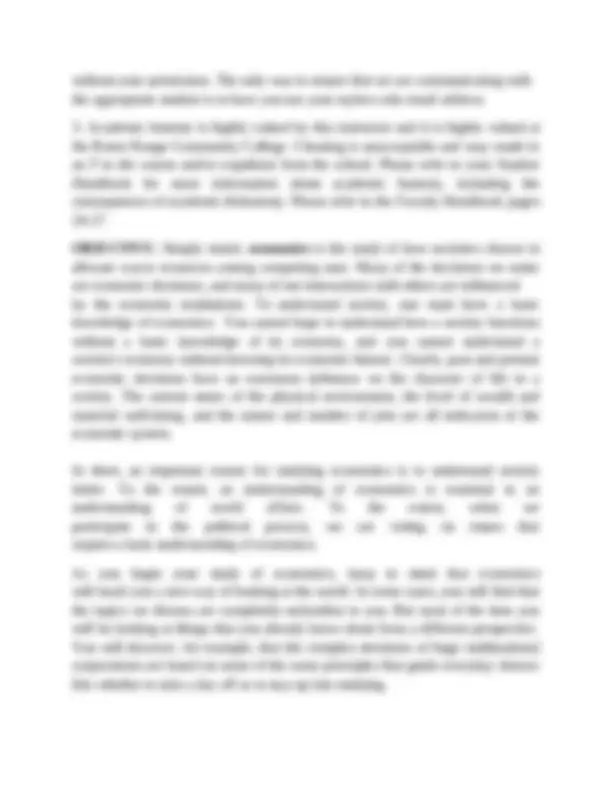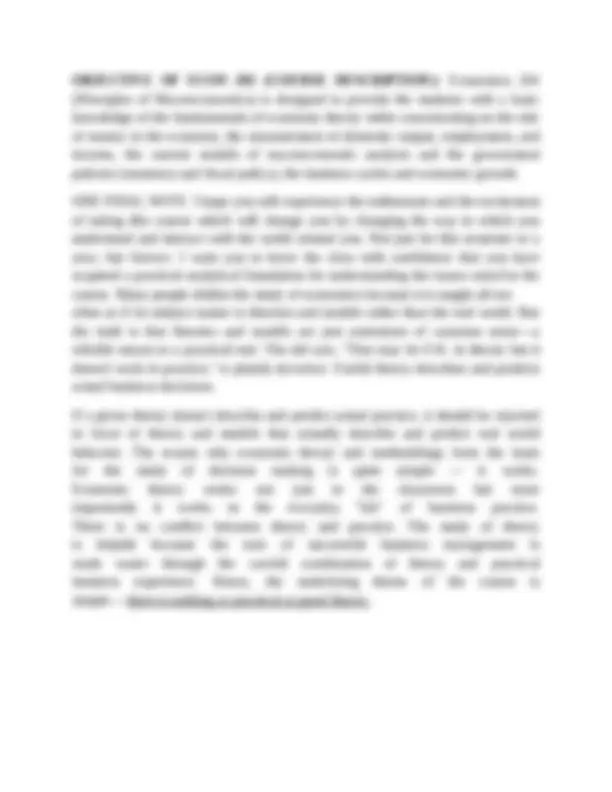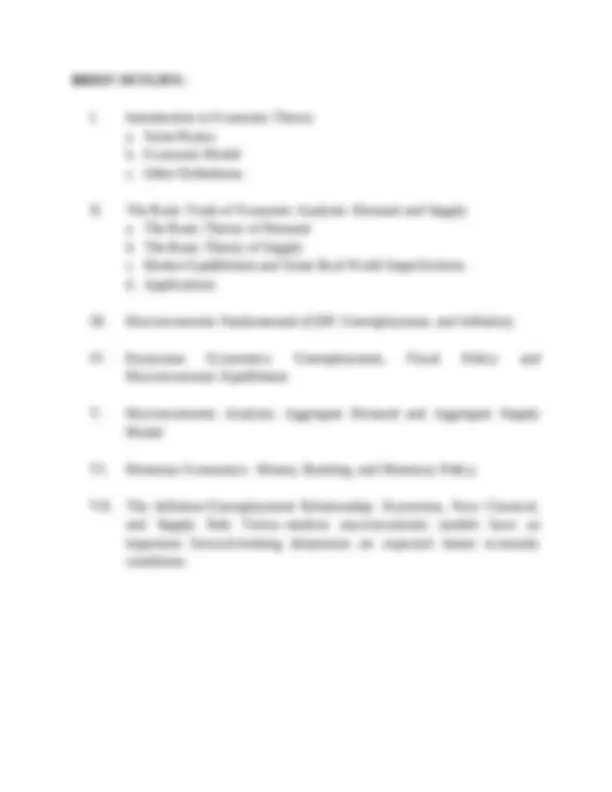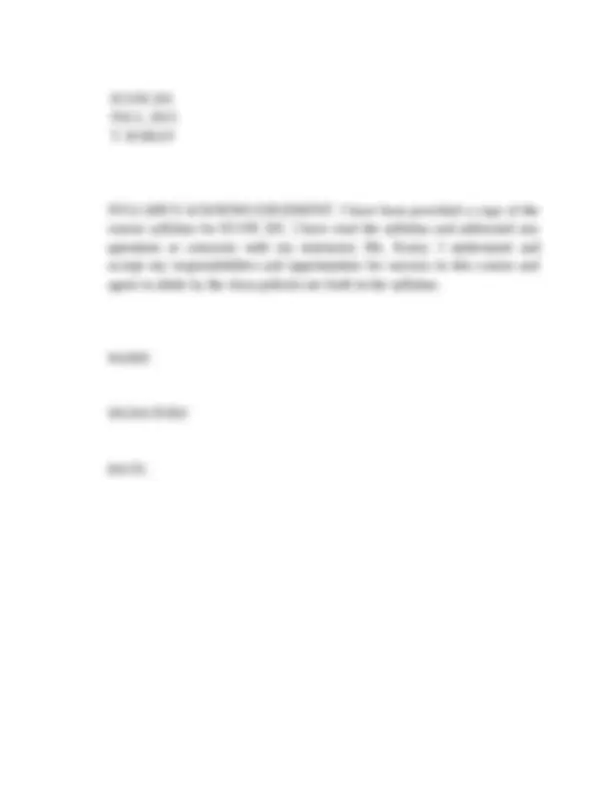







Study with the several resources on Docsity

Earn points by helping other students or get them with a premium plan


Prepare for your exams
Study with the several resources on Docsity

Earn points to download
Earn points by helping other students or get them with a premium plan
Community
Ask the community for help and clear up your study doubts
Discover the best universities in your country according to Docsity users
Free resources
Download our free guides on studying techniques, anxiety management strategies, and thesis advice from Docsity tutors
The syllabus for the principles of macroeconomics course (econ 201) taught by tulin koray at baton rouge community college in fall 2015. The syllabus includes information on lecture hours, credit hours, prerequisites, course format, attendance policy, and objectives. It also outlines the topics to be covered in the course and the expected learning outcomes.
Typology: Lecture notes
1 / 9

This page cannot be seen from the preview
Don't miss anything!






LOCATION: Baton Rouge Community College INSTRUCTOR: Tulin Koray EMAIL: korayt@mybrcc.edu TEXT: William A. McEachern, MacroEconomics 4. LECTURE HOURS: 3 LAB HOURS: 0 CREDIT HOURS: 3 Credit will not be given for this course and ECON 203. PREREQUISITES: Eligible for English 101 and Eligible for Math 094 CO-REQUISITES: None COURSE FORMAT: The class meets in Room 220 Louisiana Building on Mondays for lecture (6:00 PM – 8:30 PM). Attendance is required and materials should be read to facilitate discussions and class participation. The class starts at 6:00 pm and ends at 8:30 pm. No exceptions to this rule. Please read the following paragraph regarding the attendance policy of the college: “Class attendance is regarded as an obligation as well as a privilege. All students are expected to be punctual and to regularly attend all classes in which they are enrolled. Both tardiness and early departure from class are considered absenteeism. Failure to attend classes may jeopardize a student’s scholastic standing, disrupt the ability to receive financial aid, and/or result in the student being withdrawn from classes for excessive absences. Students are responsible for all work missed.” ( Faculty Handbook, pages 19-20)
If a student misses a class, it is the responsibility of the student to obtain information from the class mates on materials covered in class. I will not review course work missed in class via email. As indicated in the Faculty Handbook , students are responsible for all work missed. It is the responsibility of the student to check Canvas (https://mybrcc.instructure.com/login ) regularly. For all of your questions related with Canvas, please use technical support that is available 24/7. All students are required to sign the student attendance roster every week. Any student who does not sign the roster will be counted absent. Students found to be signing other students’ names to the roster will face University charges. This class will be conducted as a mixture of lectures and classroom discussions. Students will be expected to complete assigned readings before each class and to actively participate in classroom discussions. We will be analyzing the current economic events from sources such as The Wall Street Journal, Economist, New York Times, The Advocate and the Federal Reserve System publications. Watch for and read articles that are relevant to course topics and be prepared to contribute information from the articles to class discussions. Keep your handout titled “Macroeconomics on the Web” as for your future reference. This handout will be distributed on August 24, 2015. In addition, take advantage of the services that are offered by your library and the Academic Learning Center (ALC). PLEASE NOTE : 1- Cell phones and pagers are to be in the off position during the class hours. Do not take calls and listen music during class time. Text messaging is not acceptable. Laptops and all other electronic devices may not be used in class, except during the break. “All electronic devices should be turned off and placed under the desk along with any books before and during classes.” ( Student Handbook, page 36) 2- Please remember to use your mybrcc.edu email address when conducting official college-related business. The faculty and the administrators are unable to respond to emails sent from addresses that do not clearly indicate who the sender is. It violates FERPA guidelines to share your information with anyone else
OBJECTIVE OF ECON 201 (COURSE DESCRIPTION): Economics 201 (Principles of Macroeconomics) is designed to provide the students with a basic knowledge of the fundamentals of economic theory while concentrating on the role of money in the economy, the measurement of domestic output, employment, and income, the current models of macroeconomic analysis and the government policies (monetary and fiscal policy), the business cycles and economic growth. ONE FINAL NOTE: I hope you will experience the enthusiasm and the excitement of taking this course which will change you by changing the way in which you understand and interact with the world around you. Not just for this semester or a year, but forever. I want you to leave the class with confidence that you have acquired a practical analytical foundation for understanding the issues raised in the course. Many people dislike the study of economics because it is taught all too often as if its subject matter is theories and models rather than the real world. But the truth is that theories and models are just extensions of common sense---a reliable means to a practical end. The old saw, "That may be O.K. in theory but it doesn't work in practice," is plainly incorrect. Useful theory describes and predicts actual business decisions. If a given theory doesn't describe and predict actual practice, it should be rejected in favor of theory and models that actually describe and predict real world behavior. The reason why economic theory and methodology form the basis for the study of decision making is quite simple --- it works. Economic theory works not just in the classroom but more importantly it works in the everyday "lab" of business practice. There is no conflict between theory and practice. The study of theory is helpful because the task of successful business management is made easier through the careful combination of theory and practical business experience. Hence, the underlying theme of the course is simple--- there is nothing as practical as good theory.
LEARNING OBJECTIVES: Upon successful completion of this course, you will be able to: Define economics and the implications of the basic economic problem, Use demand and supply model to describe the allocative function of prices and markets, Explain macroeconomic goals, economic measurement and problems created by the business cycles, Define aggregate demand and aggregate supply and the causes of changes in macroeconomic equilibrium, Use the aggregate demand and aggregate supply model (AD/AS) to analyze the impact of government policies (fiscal policy and monetary policy), Explain monetary and fiscal policy and the appropriate use of their tools to achieve full employment, stability, economic growth, and various other goals. GRADES: Your grade in this course will be determined as follows: First one-hour test: 25% (100X25%=25) Second one-hour test: 25% (100X25%=25) Third one-hour test: 25% (100X25%=25) (The lowest grade among the first three tests will be dropped. See the example above.) Final Test (comprehensive and required): 50% (100X50%=50) DO NOT MISS THE FINAL TEST. IT IS REQUIRED. All exams will be objective in format (true/false questions and/or discussion questions might be asked) and will cover material from the textbook, lectures, and the handouts. PLEASE BRING GREEN SCANTRONS AND SIMPLE, NON PROGRAMABLE CALCULATORS FOR THE TESTS. YOU ARE NOT ALLOWED TO USE YOUR PHONE CALCULATORS. THERE WILL BE NO MAKE-UP EXAMS.
STATEMENT REGARDING SAFETY—New Emergency Notification System for BRCC: BRCC believes that your safety is important in the learning process, and makes every effort to ensure that you are secure while on campus. Please report any activity that appears unusual to the Office of Public Safety at 216-8888. You may also use one of the red telephones in the halls, the blue light pole phones outdoors, or the garage emergency phones on all floors. In an effort to improve campus communication, all students, faculty, and staff are eligible for a free BRCC Connect account. BRCC Connect will be used to provide safety and emergency information, as well as important enrollment, financial aid, and campus updates through text, voice alerts, and email. To sign up, visit the BRCC Connect portal at https://brcc.bbcportal.com/ and click on the "Sign Me Up!" link. Since January 2015, BRCC is no longer using the FIRST CALL emergency communication system. All emergency communication will be handled through the BRCC Connect system. In addition, please familiarize yourselves with the Emergency Response Plan posted in each classroom and exits in each building in which you attend class. If necessary, please exit quickly, and once outside continue to a safe distance away from the building. Take your possessions with you.
I. Introduction to Economic Theory a. Some Basics b. Economic Model c. Other Definitions II. The Basic Tools of Economic Analysis: Demand and Supply a. The Basic Theory of Demand b. The Basic Theory of Supply c. Market Equilibrium and Some Real World Imperfections d. Applications III. Macroeconomic Fundamentals (GDP, Unemployment, and Inflation) IV. Keynesian Economics: Unemployment, Fiscal Policy and Macroeconomic Equilibrium V. Macroeconomic Analysis: Aggregate Demand and Aggregate Supply Model VI. Monetary Economics: Money, Banking, and Monetary Policy VII. The Inflation-Unemployment Relationship: Keynesian, New Classical, and Supply Side Views--modern macroeconomic models have an important forward-looking dimension on expected future economic conditions.